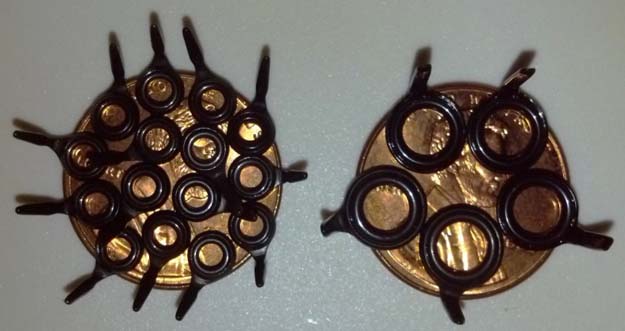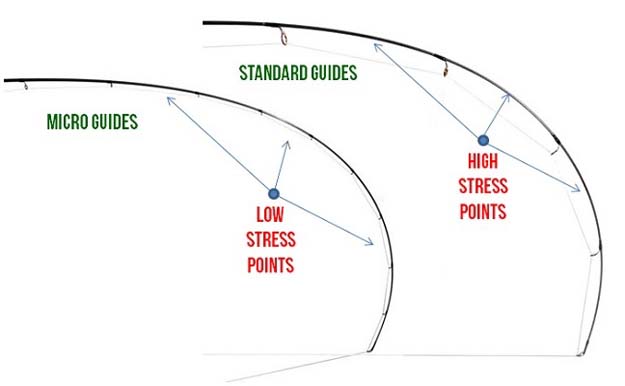[dropcap]Y[/dropcap]ou could ask a hundred visitors at any fly shop, “What are micro guides?” You’d get a plausible answer because the question itself is the answer. But as for performance advantages, pretty much clueless. In the custom rod builders’ world, micro guides have rage status in some camps. In the “bigs” nary a whimper.
What assertions are proponents of micro-guides selling?
It all centers around two very distinct issues with regard casting a line or fly line through guides of a fishing rod – any fishing rod. One, rod slap which is an unavoidable phenomenon caused by line slack between guides, which is friction. Micro guides to the rescue. Casting can be improved if the fly line remains taut between the guides – away from the blank. Less or no friction and the fly line or fishing line travels faster – voilà. That applied, build a lighter rod.
Two, as the illustration shows, the more guides along the blank – better distribution of stress. The load bearing is not focused on particular sections of the rod. Thus, micro guides reduce the concentrated stress points in the rod by evening out load distribution. The rod is stronger, lighter, more durable and casts easier and farther which further translates to less physical strain.
Reality
The current crop of great fly rod designers: Steve Rajeff (G Loomis), Annette McClean (Winston Rods), Tim Rajeff and (Echo Fly Rods), Jerry Siem (Sage), R. B. Meiser (RB Meiser Fly Rods), Tom Dorsey (Thomas & Thomas), and others have not popularized micro guides in their ad campaigns. It is more popular in custom fly rod building ranks and bass fishing with conventional gear. With the thinner line, like braided and fluorocarbon, micro-guides work best.
One of the reasons why the “bigs” in the fly rod industry have not embraced micro-guides is 100% financial. A micro-guide built rod would be warranted for a lifetime – a micro-guides rod would actuarially revisit its birthplace for fixin’ too often. Why? Because of knots. Constant restrictions through the guides, especially the tip-top, are guaranteed trips, eventually, to the repair shop. Anglers will not pay attention to their knots and resultant micro guide line passage limits.
So, if you want micro guides on a fly rod, have a custom rod builder experienced with micro guides make what you want from a blank of your choice, or redo that rod sitting in the garage that will never play ball again.
When it comes to tournament bass angling, micro-guides shine. Bernie Schultz, well-known pro bass fisherman on micro-guides (excerpted and paraphrased): “With braid or fluorocarbon and even mono. I’m convinced the micro guide layouts are the best way to fully realize the performance boosts that these lines bring to the table…. I’m a better angler – I’m thinking more about the fish and less about the equipment I’m casting with. I believe this new micro-guide technology will help the average angler too. Lighter rods, lighter and better components (micro guides) equals less fatigue.”
More to know

Micro-guides (L) compared to standard guides for similar rod – both on a penny. Elite Rods, Ohio images
The strongest a rod will ever be (its modulus rating) is when it’s a blank, no additions to it: guides, hook keeper, handle, reel seat, and fighting butt, as well as the wrapping required, paints, logo and label, adhesives and epoxies.
How could adding tiny guides to a fishing rod improve the distance you can cast? Simple, they reduce friction. The line travels from the spool or reel through micro guides and out the tip top faster.
With conventional setups, there is more space between guides – more friction via rod slap. It has a remarkably negative effect of distance. With micro guides, the line (fly line or fishing line) will transfer line from a guide to guide without significant rod contact. Sensitivity improves when casting using micro guides versus conventional guides because of the rod, being lighter, is closer to its inherent modulus responses.
Adding more guides, therefore, does not mean more weight when it comes to micro guides – about two regular guides may weigh as much as several micro guides, which also uses less wrapping to secure them as well as the clear finishing adhesive.
The use of micro guides can do all they’re claimed to do, but how much more distance? How much weight is saved? What about the crap that hangs up on a knot while fishing the salt marsh, still water ponds, and other places with flora debris? Is it efficient for a low weight fly rod like a 3- or 4-weight?
Are micro guides something to add to that old, clunker rod sitting in the garage? You be the judge.
NOTE: Featured Image credit is Hurst Fishing Service, guided trout fishing on the White River in Cotter, Arkansas.



